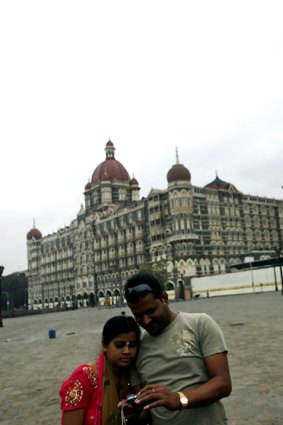
New life ... visitors in front of the Taj Mahal Palace and Tower.Credit: Reuters
Mumbai has been in the spotlight for two very different reasons in the past few months. Slumdog Millionaire, largely set in the slums of India's largest city, swept the world off its feet when it won eight Academy Awards last month. But since the November terrorist attacks, which killed more than 170 foreigners and Mumbaikars throughout the city, everyone is asking the million dollar question: is Mumbai safe?
The short answer is yes. Four months after the attacks, Mumbai seems to be regaining its composure. Security is still priority No. 1, which has the twin effect of reassuring you and reminding you of what could, and did, happen. The state government has promised to buy 36 speed boats and several helicopters for coastal patrols, upgrade Mumbai Police's weaponry and create an anti-terrorist unit called Force One.
Meanwhile, airport-style security is in place all over the city, with metal detectors manned by security guards at the entrances to many public buildings. Some tourist attractions, such as the iconic Gateway of India, are off-limits; police barricades keep visitors and locals away. The two five-star hotels at the centre of the attacks - the Taj Mahal Palace & Tower and the Oberoi Trident, both on Mumbai's waterfront - have also stepped up security.
The Taj re-opened three weeks after the attacks and now every guest, diner and visitor entering the hotel must negotiate security guards, barricades, two metal detectors, an X-ray scanner and sniffer dogs, all under the watchful electronic eye of constant CCTV video surveillance. Plain-clothes security guards patrol the hotel and its grounds. There are uniformed guards stationed on every floor of the hotel, though when I stayed there, they were unobtrusive and friendly.
It's hard to miss the water-feature memorial in the hotel's foyer, dedicated to the staff and guests who lost their lives in the attack, including the general manager's entire family.
The pages of a large visitors' book nearby echo sentiments felt all over Mumbai: what happened was tragic but the city will triumph.
It's business as usual in the Tower part of the hotel, which has 268 rooms, seven restaurants and a rooftop Banquet Hall. The Taj's historic Palace section, however - a Mumbai icon since 1903 that has hosted everyone from Gandhi to Mick Jagger - has to be re-built after the attacks.
Although the hotel's elaborate grand staircase survived the bombs and Rolex hosted a formal dinner in the Palace's newly renovated Crystal Room on March 12, the rooms will not re-open until December.
The Oberoi hotel was still closed at the time of writing but the adjacent 547-room Trident (also owned by the Oberoi group) is open. The Oberoi Care Fund was recently set up to raise money for the families of the four guests, 10 staff members and 18 people dining in the hotel's restaurants who were killed. So far it has received 3.8 million rupees ($1.2 million) and is hoping to reach a total of 5 million rupees by the end of the month.
Despite these hotel closures, this could be one of the best times to visit Mumbai and even India as a whole. Some of Mumbai's other five-star hotels are offering discounted room rates and special packages to entice guests with prices at five-star hotels across India estimated to be 30-35 per cent lower than a year ago.
Budget hotels are also reducing room rates by 8-10 per cent.
In February, India's Ministry of Tourism launched the Visit India Scheme 2009, which offers buy-one-get-one-free deals for foreigners visiting between April and December.
The offerings include complimentary international air fares from Australia for a travelling companion, as well as hotel stays and sightseeing tours. Curiosity is also bringing tourists back to Mumbai.
Some city tours seem almost like "terrorism tours" because so many landmarks were affected by the attacks. The guide on my recent city tour pointed out, for instance, the beach where the gunmen landed, the bullet marks on the walls outside Leopold Cafe and Mumbai's impressively gothic Chhatrapati Shivaji train station, also known as Victoria Terminus, where hostages were taken (which, incidentally, also played a starring role in Slumdog Millionaire).
If anything illustrated Mumbai's resilience, it was the sixth annual Mumbai Marathon, which was held in January this year. Despite being the first big public gathering after the November attacks and displaying tight security (more than 1500 police officers, 750 security guards and 1000 volunteers manned the route), the race attracted a record number of entrants - more than 35,000 people, including foreigners and runners from other parts of India.
Most telling of all were those who ran in T-shirts emblazoned with peace themes, posed for photos making the "peace" sign and shouted "Bharat Mata ki jai!" or "Victory to Mother India!" Indeed, as Vikas Swarup, author of Q&A, the book on which Slumdog Millionaire was based, wrote in an article for The Guardian the day after the attacks, "Mumbai will bounce back, as it did in 1993, 2003, 2005 and 2006. Because that is the spirit of the city - strong, resilient and unbowed."
Sign up for the Traveller Deals newsletter
Get exclusive travel deals delivered straight to your inbox. Sign up now.